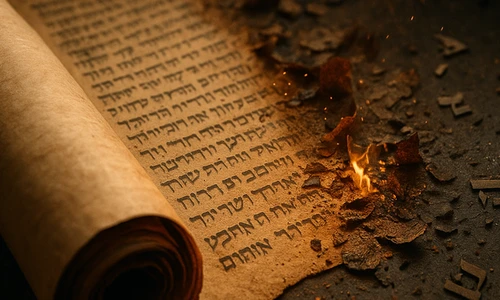Esther By the Numbers
Numbers in Scripture are often highly symbolic. The author of Esther, like the author of Revelation, went way beyond that. He inserted patterns that even a casual reader would pick up on and patterns that we’re still exploring twenty-five centuries later.
The Numbers
2 Women
The book of Esther starts not with the titular heroine but with another woman, Queen Vashti. Both women defy the king, but in completely different ways and with completely different outcomes.
During the feast at the beginning of the book, King Ahasuerus orders Vashti to appear to his assembled leaders—presumably his generals, as the feast is likely preparatory for a war—wearing her crown for “the nobles and all the other men to gaze on her beauty, for she was a very beautiful woman” (Esther 1:11). The implication, it is understood, is that she was to leave her own feast with the other women (Esther 1:9) to appear before the men wearing only the crown1.
Vashti refuses (Esther 1:12).
The king, of course, is furious. And embarrassed. He rules a kingdom! 127 provinces! But his own wife won’t obey him in his own house at his own feast?
Well, he gets angry and deposes her and goes hunting for a new, younger, more compliant wife.
Instead, he finds Esther. She’s young and beautiful and anything but compliant. Just like Vashti—apparently Ahasuerus has a type.
She is a bit more clever than Vashti, though. She bides her time, waiting for the opportune moment, and when it comes, she seizes it for everything. She overrules Ahasuerus just as effectively as Vashti did, and saves her people, and even remains queen2.
Vashti and Esther are two sides of the same coin—women in a patriarchal society whose men (Ahasuerus and Haman, respectively) have made demands they cannot bear to meet.
2 Other Women
Another pair of women to consider are Esther and Haman’s wife Zeresh. They could not be more different, except for one little detail.
At the beginning of the story, Esther is a young, single, childless Jew; Zeresh is a married Persian mother of ten and wife to the second-most-powerful man in the massive Persian Empire.
Esther takes advice from Mordecai and from fasting; Zeresh gives her husband advice about the best way to kill Mordecai.
Then everything changes. By the end of the story, Esther is the ascendant Queen of the Persian Empire, ruling the Persians and beloved by the Jews; Zeresh is the childless widow of a disgraced advisor to the king. No woman in the empire is more powerful than Esther; no woman less than Zeresh.
But there’s one interesting parallel in this narrative of reversed fortunes: Zeresh somehow knows that Mordecai, as a Jew, has some sort of supernatural protection. It appears that she did not know or did not understand, when she suggested the gallows (Esther 5:8), that Mordecai was a Jew; when she learns it later, she tells Haman that he will never be able to defeat Mordecai (Esther 6:13)3.
I’m sure Esther would agree with that.
2 Men
If Esther and Zeresh demonstrate a reversal of fortunes during the narrative of Esther, Mordecai and Haman push it to extremes.
Their rivalry drives many of the events of Esther, from the initial decree against the Jews to Haman’s building the gallows he would eventually be hanged from.
In the end, Mordecai is celebrated throughout the Empire, and Haman is dead and disgraced.
2 Royal Servants
Bigthan and Teresh, guards of the king’s private chambers, plan to assassinate King Ahasuerus (Esther 2:21). No reason is given except that they were angry. Mordecai hears of it and tells Esther, who tells the king, who has them investigated and then impaled on poles.
In the story of Joseph in Egypt, with which the story of Esther shares many similarities, there are also two royal servants: a baker and a food taster (Genesis 40:1). In that story, Pharaoh is angry at the servants rather than the other way around. He throws them in jail, where they meet Joseph, who interprets their dreams, which they remember years later. Joseph is saved and the rescue of Israel begins.
3 Pairs of Banquets
There are ten banquets in the story of Esther, but there are three prominent pairs that mark the three parts of the story:
- Beginning: King Ahasuerus’s (Esther 1:3) and Queen Vashti’s (Esther 1:9) at the beginning, where Ahasuerus calls Vashti from hers to his and kicks off the whole story.
- Climax: Esther’s two feasts to which she invites both Ahasuerus and Haman. At the first one (Esther 5:4–5), she only requests their presence at the next feast the next day. Between this feast and the next, Haman sets up a gallows, the king has insomnia, and Haman is forced to honor Mordecai. At the second, she accuses Haman of trying to destroy her people, the Jews (and Haman appears to assault her when the king leaves the room).
- End: The first Purim feast (Esther 9:17) for the Jews outside of Susa and the second Purim feast (Esther 9:18) for the Jews inside the capital.
3 Days of Fasting
In preparation for Esther’s uninvited approach to the king, which may result in her death, she requests for the Jews of Susa to fast for her for three days, during which she and her servants would also fast (Esther 4:15–17).
The period of three days, of course, has significant connections all over the Bible.
5 Chapters
Chapter and verse numbers are not divinely inspired, as far as I can tell. However, the modern chapter divisions neatly highlight the structure of the story.
The first five chapters set up the story and end on a cliffhanger: Esther has invited Ahasuerus and Haman to a banquet, only to invite them to another banquet the next day. Haman, at his wife’s suggestion, has set up a massive gallows on which to hang Mordecai. Haman’s edict threatens pretty much every living Jew. Esther 5 ends with all this tension balanced and ready to explode. As a reader, I am intensely invested in the next scene…
…only to find a thoroughly modern break in the action, as we see Ahasuerus that night in his bed, unable to sleep. This episode, right at the start of Esther 6, is the pivotal event of the entire story.
In between Esther’s feasts, Ahasuerus learns that Mordecai had informed on the assassins and saved his life. In the middle of the night, he looks around for advice on how to honor him, and there’s Haman, setting up his gallows. Haman thinks Ahasuerus means him, not Mordecai, and he suggests an ostentatious display.
Everything is downhill from there for Haman.
He has to dress Mordecai in the king’s robes, put him on the king’s horse, and lead him through the capital announcing his greatness and honor. Then he goes to the banquet and Esther accuses him of genocide. Worse, when he tries to cajole her to relent, Ahasuerus walks in on him on top of her, appearing to assault her.
Five chapters in, five chapters out. Everything hangs on that night of insomnia. A natural event with supernatural consequences for every living Jew.
7 Days of Feasting
The full feast at the beginning of Esther takes 180 days. On the seventh day, Ahasuerus gets the idea to call Vashti before him wearing only her crown to show her off to his generals and friends (Esther 1:10–11).
7 Servants
Ahasuerus sends seven servants to retrieve Queen Vashti and present her before the feast (Esther 1:10). They are all eunuchs, as usual for servants who deal with the king’s harem:
- Mehuman
- Biztha
- Harbona
- Bigtha4
- Abagtha
- Zethar
- Carkas
Why would the king need to send seven servants to get his queen? Remember that seven is a number indicating completeness, so the author’s implication is that Ahasuerus sent enough servants, or even all the servants. Again, why? Well, maybe he knew he was ordering her to do something outrageous… like stand naked in front of the massive crowd at the feast.
7 Advisors
After Vashti refuses to appear naked before his generals and friends, Ahasuerus consults his advisors—seven of them (Esther 1:13–15):
- Carshena
- Shethar
- Admatha
- Tarshish
- Meres
- Marsena
- Memucan5
Why does the king need seven advisors to help solve this problem? The symbolic number seven indicates kind of a state of panic—his wife has disobeyed him, embarrassed him, and possibly set an example for the wives of all his friends. He rules 127 provinces, but not his own wife?! Maybe he’s worried that his generals will start questioning whether he’s really fit to be king, if even his wife won’t listen to him.
He consults every advisor he can get his hands on.
7 Maidens
After deposing Queen Vashti, Ahasuerus goes looking for a younger—and presumably more controllable—queen. He sends commands across the empire, and women come flooding in, among whom is Esther. Esther, as befits our heroine, immediately impresses Hegai, “keeper of the women” (Esther 1:8).
He gives her makeup, additional food, and seven female servants, and he moves them all into “the best place in the women’s house” (Esther 1:9).
As the number of completeness, seven maidens indicates that Hegai gives Esther every possible advantage—the best living quarters, the best food, the best cosmetics, and a full complement of servants.
Every woman who made it to the palace must have been stunningly beautiful. Remember that the Persian Empire stretched from Libya halfway into Asia; Ahasuerus literally had his pick among millions of women. Esther was beautiful, but so was everyone else. So she must have impressed Hegai in other ways, with her manner, her speech, or her confidence, perhaps.
The author leaves no room for error: Esther is an amazing woman in every way.
10 Banquets
I suppose if you live in the capital of the Persian Empire, banquets are de rigueur. Even the Jews have three feasts a year. But there are ten banquets mentioned just within the short period of the story of Esther:
| Banquet | Scripture | Notes |
|---|---|---|
| 180-day banquet | Esther 1:3-4 | All the princes and servants |
| 7-day feast | Esther 1:5-8 | All the people of the palace |
| Vashti’s women’s feast | Esther 1:9 | Women of the palace |
| Esther’s coronation feast | Esther 2:18 | |
| Haman’s victory feast | Esther 3:15 | Ahasuerus and Haman celebrate the genocide of the Jews |
| Esther’s first feast | Esther 5:1-8 | Just Esther, Ahasuerus, and Haman; Esther requests a second feast |
| Esther’s second feast | Esther 7:1-10 | Esther, Ahasuerus, and Haman again; Esther accuses Haman of genocide |
| Jews’ celebration | Esther 8:17 | On the occasion of Esther’s edict for Jews to defend themselves |
| Rural Jews’ victory feast | Esther 9:17 | Celebrating the Jews’ victory over their enemies, except in Susa |
| Susa Jews’ victory feast | Esther 9:18-32 | Celebrating the Jews’ victory over their enemies, in Susa |
10 Sons of Haman
Haman had ten sons, and he was exceedingly proud of them (Esther 5:11). During the final fight between the Jews and the Persians, all ten were killed (Esther 9:7–10):
- Parshandatha
- Dalphon
- Aspatha
- Poratha
- Adalia
- Aridatha
- Parmashta
- Arisai
- Aridai
- Vaizatha
Confusingly, Esther requests that Ahasuerus hang them after the reader learns they are killed (Esther 9:13). One possibility is that she wanted to display what would happen to other enemies of the Jews, and of Esther and Mordecai in particular.
12 Months of Preparation
After the candidates for queen are gathered, they undergo twelve months of preparation: six months of “oil of myrrh” and six months of “sweet fragrances and preparations” (Esther 2:12).
The story of Esther seems to go by very, very rapidly. However, there are two significant pauses in it. This first one, for the women to be prepared to meet the king; and a second one, for the Jews to prepare themselves to meet their Persian adversaries. This first was chosen for beauty; the second was chosen for Haman’s superstition.
17 Doubles
The author of Esther delights in pairs, putting at least seventeen of them in front of us:
| Pair | Scripture | Notes |
|---|---|---|
| Lists of the king’s servants | Esther 1:10 Esther 1:14 |
1. Eunuchs 2. Advisors |
| Reports that Esther concealed her identity | Esther 2:10 Esther 2:20 |
1. Before she is chosen as queen 2. After she is chosen |
| Gatherings of women | Esther 2:8 Esther 2:19 |
1. For Ahasuerus to choose from 2. After the choosing |
| Houses for women | Esther 2:12–13 Esther 2:14 |
1. House of virgins 2. House of concubines |
| Fasts | Esther 4:3 Esther 4:16 |
1. Jews respond to Ahasuerus’s edict to kill them 2. Esther requests a three-day fast for her |
| Consultations of Haman with his wife and friends | Esther 5:10–14 Esther 6:13–14 |
1. Where Zeresh suggests the 50-cubit gallows 2. Where Zeresh predicts Haman’s downfall |
| Unscheduled appearances of Esther before Ahasuerus | Esther 5:2 Esther 8:3 |
1. To request the first of two banquets 2. To request Ahasuerus to reverse his edict killing the Jews |
| Celebrations of Mordecai | Esther 6:7–11 Esther 8:15 |
1. Honoring Mordecai for preventing the assassination of Ahasuerus 2. After Mordecai writes the edict protecting the Jews |
| Occasions where Ahasuerus and Haman drink together | Esther 3:15 Esther 7:1 |
1. Celebrating the issuance of Haman’s edict to kill all the Jews 2. Esther’s second feast, which undoes all of Haman’s plans |
| Coverings of Haman’s face | Esther 6:12 Esther 7:8 |
1. After leading Mordecai in honor through the city 2. After Ahasuerus finds him assaulting Esther at her second banquet |
| References to Haman’s sons | Esther 5:11 Esther 9:6–10, 13–14 |
1. Haman brags about “the multitude of his children” 2. The Jews kill Haman’s son, and Esther hangs them on the gallows |
| Appearances of Harbona | Esther 1:10 Esther 7:9 |
1. One of the eunuchs sent to fetch Queen Vashti 2. Points out Haman’s gallows on which to hang Haman |
| Royal edicts6 | Esther 3:12–14 Esther 8:1–13 |
1. Edict commanding the Persians to kill all the Jews 2. Edict permitting the Jews to defend themselves |
| References to the king’s anger subsiding | Esther 2:1 Esther 7:10 |
1. After Vashti defied him 2. After Haman assaulted Esther |
| References to the irrevocability of Persian laws | Esther 1:19 Esther 8:8 |
1. Regarding Vashti’s dethroning and men’s rule over their houes 2. Regarding issuing a new edict rather than reversing the one Haman wrote |
| Days for Jews to take vengeance | Esther 9:5–10 Esther 9:13–15 |
1. All the Jews 2. Just the Jews in Susa |
| Letters instituting Purim | Esther 9:20–32 Esther 9:29–32 |
1. Mordecai commands the Jews to remember Purim 2. Esther confirms the institution of Purim |
50 Cubits
Fifty cubits is about seventy-five feet. Haman’s wife Zeresh suggests that Haman build this ridiculously tall gallows on which to hang Mordecai (Esther 5:14). The height indicates Haman’s hubris (especially after he and his sons are hanged on it later) and also fits the Persian architectural fashion of massively oversized construction.
127 Provinces
The Persian Empire was divided into 127 provinces that stretch from Libya in the east to India in the west. The author juxtaposes Ahasuerus’s rule over this vast empire with his inability to make Queen Vashti obey his commands (Esther 1:1).
180 Days of Feasting
Ahasuerus hosts two feasts.
The first lasts 180 days and includes his princes and generals and many, many others. This feast may have been in preparation for a major military campaign. It showed off Persia’s vast wealth and gave the military leaders time together to plan.
The second lasts only seven days and includes only the palace personnel.
300 Men Killed
On the second day of fighting in Susa, the Jews kill three hundred Persians who attack them (Esther 9:15). This number is surprisingly small, given that 75,000 people are killed across the empire and that Susa is the capital.
500 Men Killed
On the first day of fighting in Susa, the Jews kill five hundred Persians who attack them (Esther 9:6). This number is surprisingly small, given that 75,000 people are killed across the empire and that Susa is the capital.
10,000 Talents of Silver
Haman offers the king ten thousand talents of silver in exchange for writing the edict for the Persians to wipe out the Jews (Esther 3:9). This amount is vast even for the Persian Empire: Herodotus records that the GDP of the entire empire was only fifteen thousand talents of silver. Therefore, Haman must have intended to acquire this wealth by plundering the murdered Jews, adding irony to Esther’s edict allowing the Jews to plunder their attackers instead.
75,000 People Killed
Across the Persian Empire, the Jews kill 75,000 people defending their lives and property from the Persians (Esther 9:16).
0 Mentions of God
Esther is the only book in the Bible that never mentions God. On the other hand, the fingerprints of God are all over both the book and the story it contains. The evidence is too long to fit here, but the astute reader will not fail to see God at work throughout Esther’s life.
-
The reasoning is that Vashti has no rights and would know the punishment for refusing the king’s order. So his request must have been outrageous for her to refuse it. ↩
-
Greek historians identified Vashti as maintaining a position of authority during the reign of her son, Artaxerxes I. If this is true, then Vashti, like Esther, also held on to power despite her opposition to the king. ↩
-
Extra-biblical sources suggest that Zeresh’s father is Tattenai, the Persian governor of Judah, who tried and failed to halt the rebuilding of the Temple in Jerusalem (Ezra 5:3), and this story informs her wisdom concerning Mordecai. ↩
-
There’s no reason to suspect that Bigtha the eunuch is the same as Bigthan the guard who plots to assassinate Ahasuerus. ↩
-
Some sources suggest that Memucan is an alias for Haman. It does seem weird, given Haman’s status, that he is not named among the seven advisors. He is the one who speaks in Esther 1:16, suggesting he is foremost among them, which is exactly where Haman should be. ↩
-
Ahasuerus’s very first edict commands that Vashti be stripped of her crown and that all men rule over their own houses. However, this edict is kind of silly, because men already nominally ruled over their own houses, and if they didn’t an edict wouldn’t change that. ↩



